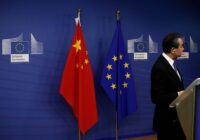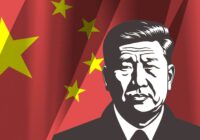The US and China are the two biggest economies in the world. Over the decades, the two countries have been opponents, friends, frenemies and rivals. The US joined the European powers in the exploitation of China, opposed the spread of communism and fought Mao Zedong’s young nation in Korea. This icy relationship thawed with Henry Kissinger’s diplomacy and Richard Nixon’s 1972 visit to China.
After Deng Xiaoping started modernizing China’s economy in the 1980s, economic relations between Washington and Beijing deepened. After Deng’s 1992 “southern tour,” which reconfirmed China’s commitment to economic liberalization and free-market reform, the economy took off exponentially. It has now become the workshop of the world. In recent years, this has created unease in the US, where the working class suffered as manufacturing moved abroad. Under President Donald Trump, relations soured, leading to the imposition of US tariffs on more than $360 billion worth of Chinese goods, and more than $110 billion of US products by China in retaliation. Now, there is talk of a new Cold War.
The trade war between the US and China presents major risks to the global economy. A study by the UN Conference on Trade and Development found that the continuing trade war by the two biggest economies, “has resulted in a sharp decline in bilateral trade, higher prices for consumers and trade diversion effects.” The study revealed that US tariffs have caused a $35-billion loss to Chinese exports in the US market. The International Monetary Fund estimates that the trade war will cause almost a percentage point loss in global growth this year.
The Coming Chinese World Order
There is also the added question about which of the two economic models is likely to prevail. With its cheap gas, immigrants from around the world, top universities, spending on research and entrepreneurial energy, many take the view that the US will come back strongly. Others say that the Chinese have the social cohesion, long-term planning, determination and a work ethic to mount a decent, if not successful, challenge.
In this guest edition of The Interview, Naveed Ahsan talks to David Petraeus — a decorated general, former head of the CIA and the chairman of the KKR Global Institute — about the US economy, American strategic priorities and US-China relations.
Naveed Ahsan: With “America First,” is the US going back to the protectionist policies of the pre-World War I era?
David Petraeus: Now let me qualify my answer a bit because there is a debate in the US — and in some other countries as well — about the benefits of international trade agreements, the value of alliances and the importance of the US continuing to lead the so-called rules-based international order. Those who believe in each of these — and I am among them — clearly have to make a more effective case than has been put forward in recent years that the benefits of each outweigh the downsides and costs that inevitably accompany trade agreements, alliance membership and global leadership.
Additionally, there has to be an acknowledgment that there are losers, as well as winners, from trade and other agreements, and that there need to be policies and resources that take better care of those disadvantaged by new trade agreements than has often been the case in the past.
Ahsan: With low gas costs, cutting-edge research, smart manufacturing, etc., is the US economy poised for another growth spurt?
Petraeus: That may be the case in some sectors, but is unlikely in aggregate. The US is, of course, in the later stages of the longest economic recovery in our history. But growth in the US has begun to slow; we have seen yield curve inversion; and growth in the eurozone and much of the developed world, as well as that in China, India and many emerging market countries, has slowed as well — in some cases approaching a technical recession.
In response, central banks around the world, including in the US, are now reducing interest rates and pursuing monetary easing as well, and some governments are also engaged in fiscal stimulus policies. Each of those actions is intended to mitigate the risk of a recession. Continued consumer spending in the US, which accounts for the vast majority of US GDP, is sustaining growth in the US at present, and some fundamentals are encouraging — low inflation despite the lowest unemployment in some 50 years, low energy costs, recent modest increases in real wage rates and still reasonably solid earnings.
But I would not anticipate a US growth spurt in aggregate, at least not until we weather the inevitable downturn that lies ahead — though no one can predict the timing or severity of the downturn, to be sure.
Certainly, some productivity enhancements being pursued will help the US economy. However, if the US wants to see a real boost to long-term growth, we will need to invest heavily in overdue infrastructure improvements that enhance productivity, achieve comprehensive immigration reform — providing, in particular, a legal pathway for unskilled workers for our agriculture, construction, and hospitality sectors; allowing more highly skilled workers for various tech sector needs; and resolving the status of the “Dreamers” and those immigrants here without adequate legal documentation.
[We need to] improve public education for the bottom 30% or so of our population, increase resources provided for research and development, and establish greater incentives and regulatory frameworks to encourage investment in new technologies, such as 5G infrastructure and communications, renewable energy sources, smart grid, etc.
Ahsan: With the rebound of American manufacturing, is the Chinese economy headed for a Japan-style showdown?
Petraeus: There are many challenges looming for manufacturing in China: displacement of some manufacturing to countries with lower labor costs and because of US tariffs; return from China of some manufacturing to the US (where more of the work is done by machines, robots and automation); loss of some manufacturing jobs inside China to robots and machines (no country will be affected more by the “rise of the robots” than will China, as its workforce in manufacturing is undoubtedly the largest in the world); and loss of some tech manufacturing because of growing concerns about supply chain risks associated with — and US restrictions on — some tech items built in China.
Those challenges — and the inevitable reduction in growth rates in China, even as growth does continue, as well as a variety of other factors — will require very skillful responses by Chinese leaders. But Chinese leadership has guided the country to achieve more in the four decades since Deng Xiaoping welcomed the world to China than any country in history has achieved in 40 years. So, just as Warren Buffett observes from time to time that “It has never paid to bet against America,” perhaps we might offer something of the same about modern China.
Ahsan: What must Washington and Beijing do to avoid the Thucydides’ Trap?
Petraeus: This is one of the central questions of the day — and likely will continue to be so for the decades ahead. From a US perspective, the US-China relationship has to be far and away the top priority of America’s foreign policy. And we need to develop a truly coherent and comprehensive approach that employs all possible American tools, together with those of our allies and partners around the world, and asks what the effect on the US-China relationship will be of every foreign policy initiative.
Beyond that, it is very clear that the US and China need to engage in sustained strategic dialogue so that each side understands the national interests of the other and so that differences can be resolved diplomatically before they get out of hand — especially given that, unlike pre-World War II situations, we are now in the nuclear age. The goal obviously should be a mutually beneficial relationship, and the key will be determining which of China’s aspirations are sufficiently legitimate that they should be accommodated, and which are not, and thus warrant firm pushback by the US and its partners.
Ahsan: What are the top three strategic priorities for the US?
Petraeus: Reflecting on the 2017 National Security Strategy, drafted under the direction of a long-time military colleague, Lieutenant General H. R. McMaster, the four priorities identified for the US are: protection of the US homeland, including the American people and our way of life; promotion of American prosperity; preservation of peace (through strength); and the advance of American influence around the world.
Ahsan: What are the top three geopolitical threats to the global economy?
Petraeus: There are numerous threats at present, but it seems to me that the top three are: first, the economic actions that have accompanied the resurgence of great power rivalries — especially, as previously highlighted, those associated with the extraordinary rise of China; second, increased challenges to the trading regimes and elements of the rules-based international order that, despite various shortcomings, has stood the world in reasonably good stead since the end of World War II; and third, populism, security issues, corruption, large-scale criminal activity and other dynamics that are undermining in many countries the elements of governance, rule of law and security that are generally required for substantial investment by foreign sources.
The views expressed in this article are the author’s own and do not necessarily reflect Fair Observer’s editorial policy.
Support Fair Observer
We rely on your support for our independence, diversity and quality.
For more than 10 years, Fair Observer has been free, fair and independent. No billionaire owns us, no advertisers control us. We are a reader-supported nonprofit. Unlike many other publications, we keep our content free for readers regardless of where they live or whether they can afford to pay. We have no paywalls and no ads.
In the post-truth era of fake news, echo chambers and filter bubbles, we publish a plurality of perspectives from around the world. Anyone can publish with us, but everyone goes through a rigorous editorial process. So, you get fact-checked, well-reasoned content instead of noise.
We publish 2,500+ voices from 90+ countries. We also conduct education and training programs
on subjects ranging from digital media and journalism to writing and critical thinking. This
doesn’t come cheap. Servers, editors, trainers and web developers cost
money.
Please consider supporting us on a regular basis as a recurring donor or a
sustaining member.
Will you support FO’s journalism?
We rely on your support for our independence, diversity and quality.






